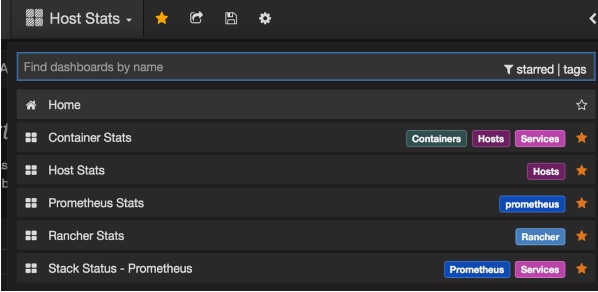
- Kubernetes Tutorial
- Kubernetes - Home
- Kubernetes - Overview
- Kubernetes - Architecture
- Kubernetes - Setup
- Kubernetes - Images
- Kubernetes - Jobs
- Kubernetes - Labels & Selectors
- Kubernetes - Namespace
- Kubernetes - Node
- Kubernetes - Service
- Kubernetes - Pod
- Kubernetes - Replication Controller
- Kubernetes - Replica Sets
- Kubernetes - Deployments
- Kubernetes - Volumes
- Kubernetes - Secrets
- Kubernetes - Network Policy
- Advanced Kubernetes
- Kubernetes - API
- Kubernetes - Kubectl
- Kubernetes - Kubectl Commands
- Kubernetes - Creating an App
- Kubernetes - App Deployment
- Kubernetes - Autoscaling
- Kubernetes - Dashboard Setup
- Kubernetes - Monitoring
- Kubernetes Useful Resources
- Kubernetes - Quick Guide
- Kubernetes - Useful Resources
- Kubernetes - Discussion
Kubernetes - Monitoring
Monitoring is one of the key component for managing large clusters. For this, we have a number of tools.
Monitoring with Prometheus
It is a monitoring and alerting system. It was built at SoundCloud and was open sourced in 2012. It handles the multi-dimensional data very well.
Prometheus has multiple components to participate in monitoring −
Prometheus − It is the core component that scraps and stores data.
Prometheus node explore − Gets the host level matrices and exposes them to Prometheus.
Ranch-eye − is an haproxy and exposes cAdvisor stats to Prometheus.
Grafana − Visualization of data.
InfuxDB − Time series database specifically used to store data from rancher.
Prom-ranch-exporter − It is a simple node.js application, which helps in querying Rancher server for the status of stack of service.

Sematext Docker Agent
It is a modern Docker-aware metrics, events, and log collection agent. It runs as a tiny container on every Docker host and collects logs, metrics, and events for all cluster node and containers. It discovers all containers (one pod might contain multiple containers) including containers for Kubernetes core services, if the core services are deployed in Docker containers. After its deployment, all logs and metrics are immediately available out of the box.
Deploying Agents to Nodes
Kubernetes provides DeamonSets which ensures pods are added to the cluster.
Configuring SemaText Docker Agent
It is configured via environment variables.
Get a free account at apps.sematext.com, if you don’t have one already.
Create an SPM App of type “Docker” to obtain the SPM App Token. SPM App will hold your Kubernetes performance metrics and event.
Create a Logsene App to obtain the Logsene App Token. Logsene App will hold your Kubernetes logs.
Edit values of LOGSENE_TOKEN and SPM_TOKEN in the DaemonSet definition as shown below.
Grab the latest sematext-agent-daemonset.yml (raw plain-text) template (also shown below).
Store it somewhere on the disk.
Replace the SPM_TOKEN and LOGSENE_TOKEN placeholders with your SPM and Logsene App tokens.
Create DaemonSet Object
apiVersion: extensions/v1beta1
kind: DaemonSet
metadata:
name: sematext-agent
spec:
template:
metadata:
labels:
app: sematext-agent
spec:
selector: {}
dnsPolicy: "ClusterFirst"
restartPolicy: "Always"
containers:
- name: sematext-agent
image: sematext/sematext-agent-docker:latest
imagePullPolicy: "Always"
env:
- name: SPM_TOKEN
value: "REPLACE THIS WITH YOUR SPM TOKEN"
- name: LOGSENE_TOKEN
value: "REPLACE THIS WITH YOUR LOGSENE TOKEN"
- name: KUBERNETES
value: "1"
volumeMounts:
- mountPath: /var/run/docker.sock
name: docker-sock
- mountPath: /etc/localtime
name: localtime
volumes:
- name: docker-sock
hostPath:
path: /var/run/docker.sock
- name: localtime
hostPath:
path: /etc/localtime
Running the Sematext Agent Docker with kubectl
$ kubectl create -f sematext-agent-daemonset.yml daemonset "sematext-agent-daemonset" created
Kubernetes Log
Kubernetes containers’ logs are not much different from Docker container logs. However, Kubernetes users need to view logs for the deployed pods. Hence, it is very useful to have Kubernetes-specific information available for log search, such as −
- Kubernetes namespace
- Kubernetes pod name
- Kubernetes container name
- Docker image name
- Kubernetes UID
Using ELK Stack and LogSpout
ELK stack includes Elasticsearch, Logstash, and Kibana. To collect and forward the logs to the logging platform, we will use LogSpout (though there are other options such as FluentD).
The following code shows how to set up ELK cluster on Kubernetes and create service for ElasticSearch −
apiVersion: v1
kind: Service
metadata:
name: elasticsearch
namespace: elk
labels:
component: elasticsearch
spec:
type: LoadBalancer
selector:
component: elasticsearch
ports:
- name: http
port: 9200
protocol: TCP
- name: transport
port: 9300
protocol: TCP
Creating Replication Controller
apiVersion: v1
kind: ReplicationController
metadata:
name: es
namespace: elk
labels:
component: elasticsearch
spec:
replicas: 1
template:
metadata:
labels:
component: elasticsearch
spec:
serviceAccount: elasticsearch
containers:
- name: es
securityContext:
capabilities:
add:
- IPC_LOCK
image: quay.io/pires/docker-elasticsearch-kubernetes:1.7.1-4
env:
- name: KUBERNETES_CA_CERTIFICATE_FILE
value: /var/run/secrets/kubernetes.io/serviceaccount/ca.crt
- name: NAMESPACE
valueFrom:
fieldRef:
fieldPath: metadata.namespace
- name: "CLUSTER_NAME"
value: "myesdb"
- name: "DISCOVERY_SERVICE"
value: "elasticsearch"
- name: NODE_MASTER
value: "true"
- name: NODE_DATA
value: "true"
- name: HTTP_ENABLE
value: "true"
ports:
- containerPort: 9200
name: http
protocol: TCP
- containerPort: 9300
volumeMounts:
- mountPath: /data
name: storage
volumes:
- name: storage
emptyDir: {}
Kibana URL
For Kibana, we provide the Elasticsearch URL as an environment variable.
- name: KIBANA_ES_URL value: "http://elasticsearch.elk.svc.cluster.local:9200" - name: KUBERNETES_TRUST_CERT value: "true"
Kibana UI will be reachable at container port 5601 and corresponding host/Node Port combination. When you begin, there won’t be any data in Kibana (which is expected as you have not pushed any data).